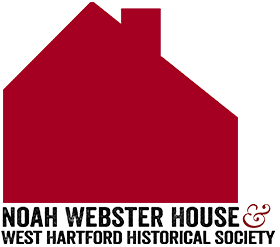Noah’s Family
Noah’s Father: Noah Webster, Sr.
Noah Webster, Sr. was the son of Daniel and Miriam Kellogg Webster and a descendant of John Webster, the first governor of Connecticut. He was born in the West Division on March 25, 1722 and married Mercy Steele on January 12, 1749 when he was 26 years of age. He was a farmer and a weaver. Noah, Sr. served in the French and Indian War and was a militia captain on the alarm list, for men over forty-five, during the Revolution. In addition, he was involved in the Congregational Church and at one time even served as deacon. He was also appointed by the Connecticut state legislature to serve as a justice of the peace from 1781 to 1796. In 1806, twelve years after Mercy’s death, at 84 years of age, Noah, Sr. married Sarah Hopkins and went to live on her farm in another part of the West Division. He died on November 9, 1813 at the age of 91 and was buried in the Center Cemetery.
Noah’s Mother: Mercy Steele Webster
Mercy, born in 1727, was the daughter of Eliphalet and Catherine Steele. Mercy was a descendant of William Bradford. She married Noah Webster, Sr. in 1749 when she was 22 years old. Rebecca Greenleaf Webster remembered Mercy “as a woman of great intelligence and energy; a gentle loving mother and care-taker, looking well to the ways of her household…who…carried on the farm quite successfully while her husband and sons were in the war of the Revolution.” Mercy was 67 when she died in 1794, possibly of dysentery. She was buried in Center Cemetery, where her husband would eventually join her.
Noah’s Eldest Sister: Mercy Webster Belding
Mercy was born on November 8, 1749. She married John Kellogg Belding on September 18, 1769, at the age of 19. Mercy and John lived a few miles away from Noah, Sr., on today’s Mountain Road. They had seven children, two of whom died as infants. Mercy died on August 12, 1820. She was 70 years old.
Noah’s Eldest Brother: Abraham Webster
Abraham was born on September 17, 1751. In 1774, at the age of 23, he was given one-half acre of land and a house across from what is now the Rockledge Country Club. In January of 1775, he married Rachel Merrill of New Hartford. Rachel died in child-birth on January 19, 1776, and their son died just six days later. Both were buried in the Center Cemetery, next to where the Websters would eventually be buried. On February 1, 1776, just after his wife’s death, Abraham enlisted in the Continental Army, joined his company at Canaan and marched to Albany, then to Fort George, Ticonderoga, then on to Montreal. He was captured during the Battle of the Cedars in the spring of 1776, but was released due to smallpox. Abraham’s enlistment ended on February 1, 1777. After he returned to the West Division, his father gave him an additional 10 acres of land. He married Dorothy (Dolly) Seymour on February 17, 1778 and they had five children, all of whom were born in the West Division prior to 1786. In 1790, Abraham moved his family to Stockbridge, Massachusetts, but by 1803 they were living in Hamilton, New York. Dolly died in 1819 and Abraham married Eunice Childs, his third wife, in 1822. He died in New York in 1831 at age 80.
Noah’s Older Sister: Jerusha Webster Lord
Jerusha was born on January 22, 1756 and married Joel Lord of Salisbury, Connecticut on November 12, 1778, when she was 22 years of age. Noah may have lived with them during the year 1780-81. Jerusha and Joel moved to Darby, Thompkins County, New York where Jerusha died on February 21, 1821, at the age of 64. Jerusha’s and Abraham’s moves westward to New York were typical of their generation. Many of their contemporaries left Connecticut as land grew scarcer.
Noah’s Younger Brother: Charles Webster
Charles was born on September 2, 1762. He married Betsy Woodruff of Farmington on December 11, 1783 when he was 21 years old. Betsy bore three sons. In 1787, a letter written to Noah by Charles indicated that he was adding a brick lean-to onto his parents’ home. In 1791 Charles bought a house near the meeting house, and his parents might have lived there with him. During this time, Charles operated a store in which he sold “European and India goods,” crockery, nails, fabrics, groceries and hardware. In 1799, he became a Quaker and sold his house. The following year Charles and his family moved to Park Road, where his wife Betsy owned a house. She died in 1810 at the age of 51. In 1811 Charles married Joanna Wilkinson. They had two children before Charles died in 1817 at age 55.





